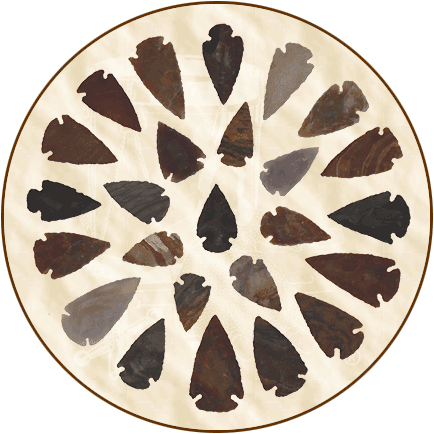.
Continued from product description on
Native American's Page Three...
Historical
Background: Arrowheads are called projectile points
attached to the end of a feathered shaft. Of all the archeological
artifacts we associate with Stone Age man, we most likely think
of stone arrowheads.
Arrowheads are usually made of stone (such as flint and obsidian)
but they have also been made from bone, wood, ivory, and metal.
Today, arrowheads are made of synthetic materials or metals,
except in existing old-world civilizations, where the ancient
art of knapping is still practiced.
An arrowhead consists of two parts: the pointed tip
and the haft that is fastened to an arrow's shaft. The
size of an arrowhead can be used to determine how old it is.
Larger, wider arrowheads are older while later arrowhead sizes
are thinner and narrower.
Modern broad head arrowheads are composed of many blades that
are set wider than most arrowheads. This design allows the arrowhead
to hit more arteries and veins. Many arrowheads have barbs
which act as hooks to make their removal difficult and painful.
Since the dawn of man, our ancestors scavenged and gathered
for food and other survival needs. As he foraged he likely observed
animals hunting and eating other animals. Perhaps he came across
the remains of an animal's carcass. Perhaps he learned to catch
slower animals or, perhaps, he learned to throw stones to down
an animal. In any event, man acquired an appetite for meat and
a digestive system for it. Man was now both a gatherer and a
hunter.
As man evolved, so did his tools. He learned to take two stones
and strike them together in a skilled manner to produce a flat,
pointed stone with sharp edges. He also learned to fasten this
sharp, triangularly shaped stone to the end of long, wooden rod
to produce a spear. With these spears, man was able to
hunt and defend his territory.
Levalloisian flake tools were refined by Neanderthals during
the Middle Stone Age or Mousterian Period. It is likely that
stone points were first attached to spears around 166,000 years
ago.
The next "great leap" in technology was made by Homo
Sapiens during the Sulutrean part of the Upper Paleolithic Period
from about 21,000 to 17,000 years ago.
The Sulutreans are acknowledged for having the skill and artistry
to make the delicate and effective willow leaf point.
They are also generally believed to be responsible for the atlatl
or throwing stick. Atlatls are a sophisticated combination tool
formed out of a short dart with a point socketed into a longer
shaft. A leather strap hooked at the far end allowed the user
to fling their atlatl over the shoulder. This "throwing"
action caused the dart to fly off towards its target with accuracy
as well as from a safe distance.
Hunting with spears was an improvement over hunting with clubs
and throwing stones. First, spears could be thrown with enough
force to impact the target or be used as a lance with a jabbing
action. Second, the spearhead's shape usually prevented the spear
from coming out of the wound. Third, a hunter could throw his
spear from a greater distance thus increasing his range of attack
while at the same time reducing his risk for reprisal from his
prey. Fourth, a solid hit with a spear could cause prolonged
trauma for the animal as it tried to escape bouncing a long stick
that acted as a lever to move the spearhead's sharp edges to
cause greater internal bleeding and, ultimately, the animal to
collapse and be caught.
It is, of course, not recorded how man made the jump from
spear throwing to bows and arrows. All we have for a record are
the projectile points that have been found around the world.
The oldest arrowheads are found i n Africa and have been dated
from before 25,000 BC. Sometime between 25,000 and 18,000 BC
(when man gained mastery over fire), man began to fire-harden
stone arrowheads.
One cannot think about arrows without thinking about a bow.
Bows made from one piece of elm or yew have been recovered in
Denmark and are dated between 8,000-6,000 BC. Egyptian drawing
(7500-5000 BC) show bows being used for both hunting and warfare.
Arrowheads are referred to as projectile points by archeologists
because many other types of materials besides stone were used
as sharp points on all sorts of projectiles. And while the technology
has evolved over time, projectile points' sole purpose has been
hunting and warfare. Projectile points have been made used stone,
wood, bone, antler, copper, bronze (a copper-tin alloy) and any
material that could be made into a point with sharp edges.
Many types of arrowheads have been found in North America.
Most of these arrowheads are made from flint, obsidian and quartz.
Other materials, however, have been used to make stone tools
and arrowheads in though out the Americas.
Flint and stone was the material of choice for most utilitarian
tools. Since iron does not arrive until around 8000 BC, everyday
objects such as axes, hammers, celts, chisels, awls and jewelry
was made using stone.
It took a high degree of intelligence and skill to make stone
tools. Most arrow-hafted projectile points are under 2 inches
in length (anything larger would be make the arrow too heavy).
The oldest arrowheads found in North America are from the
Paleo Period (9,000-15,000 years ago). These artifacts are based
on DNA test results and carbon dating whenever possible. It is
believed the arrowhead technology came from Asia through the
Bering Straight and, possibly, from across the Pacific Ocean
to South America. This is credible when one considers the similarities
of the more famous arrowhead point types such a Clovus, Folsom
and Dalton.
Myths. Arrowheads are among the oldest tools we have from
early man. They have, over the years, acquired some myths:
· all triangular stone objects found on archeological
sites are arrowheads;
· the smallest arrowheads were used for bird hunting;
· the hafted tools with the round ends are meant for stunning
prey rather than killing it;
· the reason why so many projectile points are found is
because there was a lot of tribal warfare during the Stone Ages;
· arrowheads are made by heating a rock and dipping it
in water;
· it takes a long time to make an arrowhead; and,
· all arrows had stone projectile points attached to "balance"
the shafts.
Facts. Here are some little known facts about arrowheads:
· by and large, one can tell how old a projectile point
is or where it came from by its shape and size;
· archeologists use a microscope and chemical analysis
to identify scratches and minute traces of blood or other substances
on the edges of projectile points;
· broken points tell us more than whole one;
· archeologists sometimes use broken arrowheads and other
projectile points as interpretive tools; and,
· some native cherts and flints improve their character
by being exposed to heat.
Fun
Fact: The word "atlatl" (pronounced either "at-ul-al-ul"
or "aht-lah-tul") is the Aztec word for "throwing
stick." When Cortez landed on the eastern shore of Mexico
in the 1500s, he and his men were greeted by atlatl-weilding
Aztecs. It was a good thing the Aztecs mistook Cortez for being
the god Quetzalcoatl!













